What are the cultivation methods and precautions of African jasmine?

African Jasmine IntroductionAfrican jasmine is a plant of the genus African jasmine in the Loganaceae family. Its original name is Chinese African jasmine, and its aliases include African African jasmine, African African jasmine fruit, etc. Generally, the ripe fruits of African jasmine are collected between October and December, and then sown for propagation. The seedlings will not emerge until the spring of the following year. They can also be propagated by cuttings during the rainy season from June to July. African jasmine cultivation methodAfrican jasmine likes an environment with plenty of sunlight, but needs to avoid exposure to strong sunlight in summer. It likes an environment with high air humidity and good ventilation. It is not cold-resistant. The suitable growth temperature is between 18-32 degrees, not higher than 38 degrees or lower than 0 degrees. It grows best in loose, fertile, well-drained loam. Watering methodAfrican jasmine likes a humid environment and has a high demand for water in summer. If it is not watered in time, the new shoots will wilt and droop. At this time, do not rush to water it, but spray some water on the leaves first, wait until it recovers, and then water the potting soil with an appropriate amount of water. Fertilization methodDuring the growth period of African jasmine, apply a thin layer of cake fertilizer water every half a month. Apply phosphorus and potassium fertilizers before flowering in May to promote flower bud differentiation. After autumn, apply phosphorus and potassium fertilizers 1-2 times to ensure a safe winter. If potted in the northern region, add 0.2% ferrous sulfate. Pruning methodsAfrican jasmine can have its branches pruned short, and dead, diseased, and thin branches can be cut off in time during the growth period. When repotting every year, the roots can be trimmed and new culture soil can be replaced. After pruning, the number of waterings can be reduced. African jasmine cultivation precautionsAfrican jasmine is prone to anthracnose, which affects the growth of leaves and tenderer branches. If left untreated, the entire plant may even die. It needs to be controlled with carbendazim. Common pests are the short-fronted locusts, which reproduce quickly and cause greater damage. They can be eliminated with dichlorodiphenyltrichloroethane. |
<<: What are the cultivation methods and precautions for large potted green radish?
>>: What are the cultivation methods and precautions of perilla
Recommend
Cultivation methods and precautions of Amaryllis
Amaryllis is a perennial herb of the Amaryllis fa...
How to change the pot of Jing Ye
Quiet night potting preparation Generally speakin...
Can jasmine survive if its leaves turn yellow? What should I do if the leaves turn yellow?
1. Can the plant survive if yellow leaves appear?...
How to prune the hanging bamboo
How to prune the hanging bamboo First, the growth...
Does Osmanthus fragrans prefer shade or sun?
Does Osmanthus fragrans prefer shade or sun? Swee...
How to prune heartleaf vine
1. Pruning method After entering spring, you can ...
The growth environment and local conditions of the pepper tree
The growing environment and conditions of the pep...
How to grow Spathiphyllum and precautions How to grow Spathiphyllum
Spathiphyllum is a perennial herb of the Araceae ...
What kind of soil is best for the fortune tree?
1. Requirements for soil (1) First of all, it nee...
Is it good to eat dragon fruit at night? Can I eat dragon fruit at night?
1. Can I eat it? It is usually not recommended to...
Do avocados need to be pruned? How to prune avocados?
1. Does it need pruning? Avocado needs pruning. P...
What are the cultivation methods and precautions of Strelitzia reginae
How to grow Crane orchid Strelitzia reginae likes...
Planting technology and cultivation of pitaya
1. Seed treatment Prepare a dragon fruit, peel of...
Still using "soybean water" to water flowers? Nowadays, people use these "3 kinds" of water, and the flowers bloom more and more vigorously
Some people say that growing flowers is a big pit...
How to prevent and treat green algae in the fish tank?
The growth of green algae in fish tanks is a comm...









